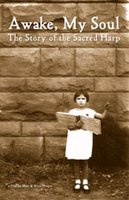 If you enjoyed Awake, My Soul, the recently aired documentary on Sacred Harp singing (also known as shape-note, or fasola, singing), then be sure to tune in to Public Radio International's Sound and Spirit this Sunday, December 3. Host Ellen Kushner will be featuring "shape-note singing from the Sacred Harp and other collections of American mountain folk hymns," as well as "concert music from American composers inspired by this rough and ready American hymnody."
If you enjoyed Awake, My Soul, the recently aired documentary on Sacred Harp singing (also known as shape-note, or fasola, singing), then be sure to tune in to Public Radio International's Sound and Spirit this Sunday, December 3. Host Ellen Kushner will be featuring "shape-note singing from the Sacred Harp and other collections of American mountain folk hymns," as well as "concert music from American composers inspired by this rough and ready American hymnody."
Sacred Harp singers are very knowledgeable about the history and traditions of their music, and the web has many good sites on this distinctly American musical form. Poke around for just a little while and you'll notice the names Buell E. Cobb Jr. and John Bealle appearing repeatedly in resource listings about shape-note music. Cobb is the author of THE SACRED HARP: A TRADITION AND ITS MUSIC and Beall is the author of PUBLIC WORSHIP, PRIVATE FAITH: SACRED HARP AND AMERICAN FOLKSONG.
Praised by American Music as a "thoroughly researched 'inside' view," Buell Cobb's book is an ideal introduction to Sacred Harp singing. John Bealle asks why one particular hymnal, The Sacred Harp, first published in 1844, has outlived so many other shape-note song collections. To help explain the songbook's enduring popularity, Bealle studies it in the context of a century and a half of American musical history. As the Alabama Review wrote, PUBLIC WORSHIP, PRIVATE FAITH "brims with insights on a variety of topics."
Resources:
Awake, My Soul producer Matt Hinton was interviewed on the 11/10/06 editon of Georgia Gazette by host Rickey Bevington. Listen to it on the web. Interview begins at 14:33 into the show.
The New Georgia Encyclopedia's article on Sacred Harp singing.
Great photos of contemporary shape-note singing on the Flickr Fasola pool.
A Sacred Harp FAQ.
Some shape-note lyrics understandably have become a bit archaic or obscure over time. Here's a lexical companion that sheds light on words, phrases, and references in a number of songs.
Top left: Poster for the documentary Awake, My Soul.
Top right: Cover of John Bealle's PUBLIC WORSHIP, PRIVATE FAITH.
Bottom left: Cover of Buell E. Cobb Jr's THE SACRED HARP.
Bottom right: Some lines of music showing distinctive "shape notes": triangle (fa), a circle (sol), a rectangle (la), and a diamond (mi). Courtesy of Atlanta Sacred Harp Singers.





